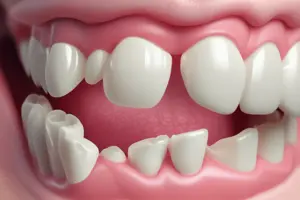Podcast
Questions and Answers
What are the border structures that limit the periphery of the denture base?
What are the border structures that limit the periphery of the denture base?
Limiting structures
Which structure requires a notch in the denture opposite to it?
Which structure requires a notch in the denture opposite to it?
- Lingual Frenum
- Labial Frenum (correct)
- Masseter muscle area
- Buccal Frenum
The buccal vestibule limits the denture flange thickness and length.
The buccal vestibule limits the denture flange thickness and length.
True (A)
What is the primary stress bearing area in the mandibular arch?
What is the primary stress bearing area in the mandibular arch?
The anteior exit of the mandibular canal is called the __________.
The anteior exit of the mandibular canal is called the __________.
Where should the lower denture not extend beyond to avoid displacement?
Where should the lower denture not extend beyond to avoid displacement?
What is indicated if severe resorption appears in the residual alveolar ridge?
What is indicated if severe resorption appears in the residual alveolar ridge?
The distobuccal flange of the denture should be contoured to allow freedom of the masseter muscle.
The distobuccal flange of the denture should be contoured to allow freedom of the masseter muscle.
What is the role of the palatoglossal arch in denture design?
What is the role of the palatoglossal arch in denture design?
The area influencing the Mylohyoid muscle is also known as the __________.
The area influencing the Mylohyoid muscle is also known as the __________.
Flashcards are hidden until you start studying
Study Notes
Mandibular Limiting Structures
- Labial Frenum: A fold of mucous membrane that connects the lip to the gingiva. A notch is made in the denture to accommodate the frenum.
- Labial Vestibule: Limits the denture flange thickness and length.
- Buccal Frenum: A fold of mucous membrane in the premolar area. A notch is made in the denture to accommodate the frenum.
- Buccal Vestibule: The lower denture flange should extend into the buccal vestibule since buccinator contraction doesn't displace the denture.
- Masseter Muscle Influencing Area (Masseteric Notch): The distobuccal flange of the denture should be contoured to allow free muscle movement, preventing denture displacement and soreness.
- Posterior End of Retromolar Pad: The posterior limit of the lower denture where postdamming can be performed.
- Palatoglossal Arch: Disto-lingual border of the lower denture is related to the palato-glossal arch (formed by palato-glossal muscles). Denture overextension in this area causes sore throat.
- Lingual Pouch: A space located between the palatoglossus muscle posteriorly, mylohyoid muscle anteriorly, tongue medially, and the medial aspect of the mandible laterally.
- Mylohyoid Muscle Influencing Area (Internal Oblique Ridge): The lower denture shouldn't extend beyond the Internal Oblique Ridge to avoid displacement by the mylohyoid muscle.
- Sublingual Salivary Gland Area: The lingual flanges of the lower denture should not extend into this area, as the gland may bulge superiorly with significant mandible resorption.
- Lingual Frenum: A fold of mucous membrane attaching the undersurface of the tongue to the floor of the mouth. A notch is made to accommodate the frenum.
Mandibular Intra-Oral Landmarks
- Residual Alveolar Ridge: The portion of the alveolar process remaining after tooth extraction. It is primarily cancellous bone, and severe resorption can lead to flabby tissue requiring special impression techniques or surgical intervention.
- External Oblique Ridge: A dense bony ridge descending obliquely from the ramus of the mandible. The lower denture should cover the EOR but not extend beyond to avoid displacement by the masseter muscle.
- Buccal Shelf of Bone: A primary stress-bearing area, bordered externally by the external oblique line and internally by the residual ridge slope. It is parallel to the occlusal plane and has dense bone.
- Mental Foramen: The anterior exit of the mandibular canal and the mental nerve. With severe resorption, the foramen may occupy a more superior position. Denture base must be relieved to prevent nerve compression, pain, and numbness of the lower lip.
- Retromolar Pad: A pear-shaped soft tissue pad present bilaterally at the distal end of the residual ridge. It is an important landmark for denture extension and posterior seal.
Studying That Suits You
Use AI to generate personalized quizzes and flashcards to suit your learning preferences.




